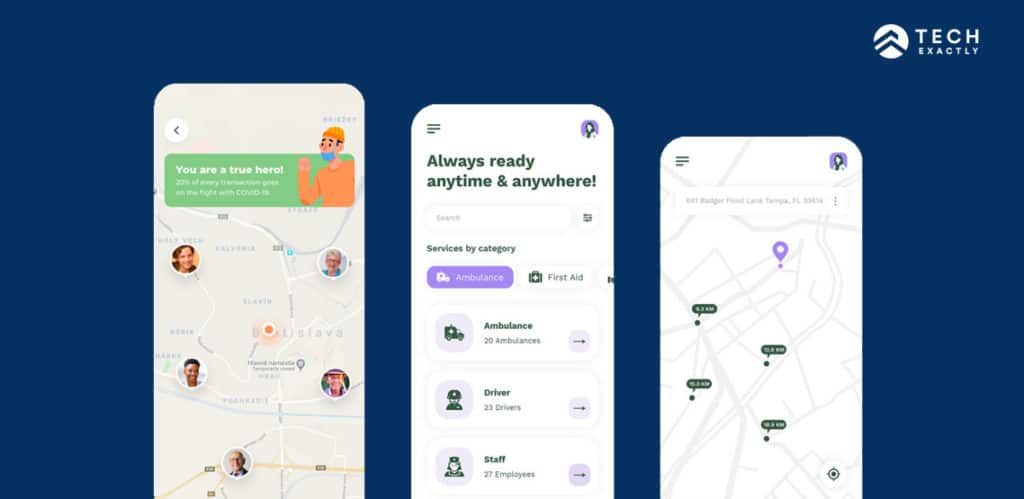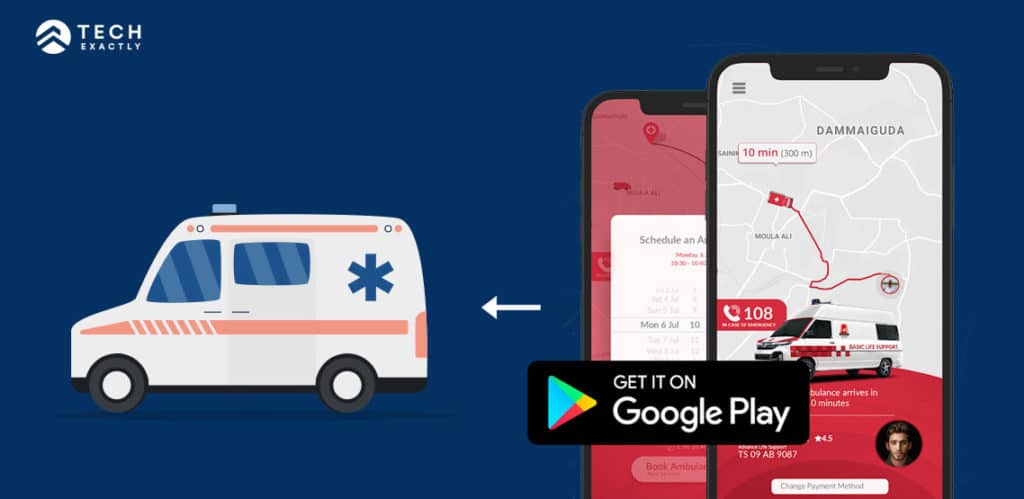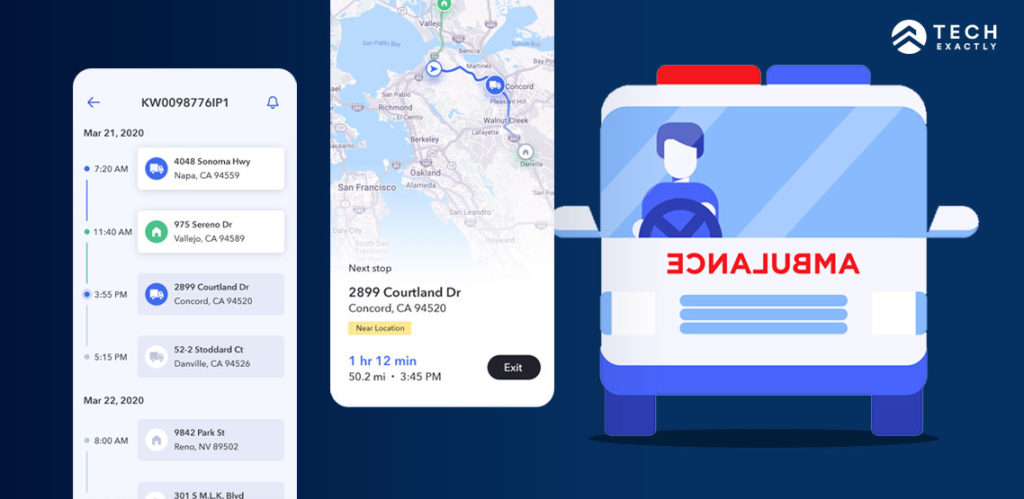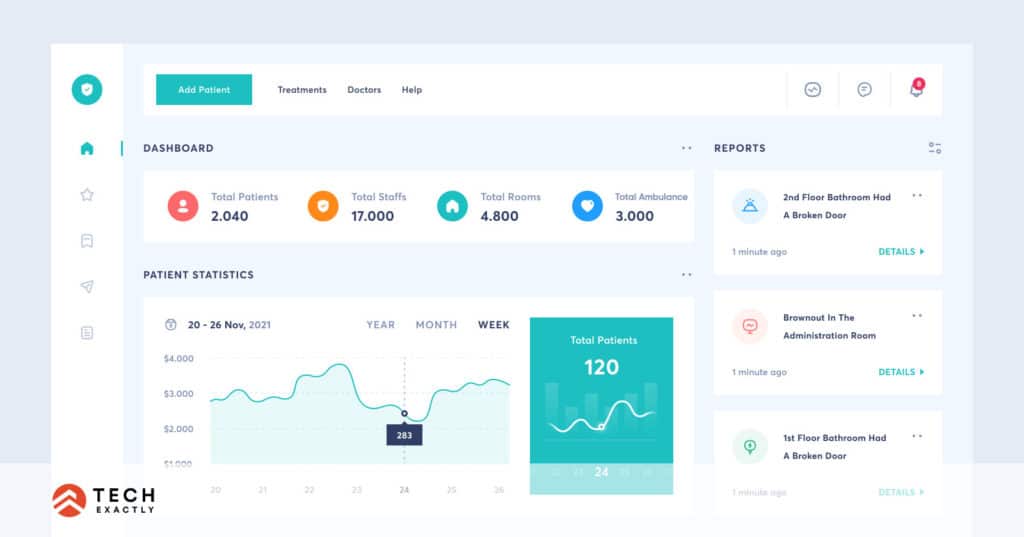How to Build an App To Improve Emergency Medical Services

According to a recent report by Statista.com, the total global mHealth market is expected to reach over 100 billion U.S. dollars by the end of 2024. This will be a more than fivefold increase from around 21 billion dollars in the year 2016.
An ambulance is the first thing that comes to the mind of people in medical distress. Available in various shapes and sizes, modern ambulances include all sorts of first aid required, such as heart defibrillators, oxygen supply, external pacemakers, cardiac monitors, intravenous drips, etc.
Despite the availability of modern features, on-time availability of ambulances continues to be a concern for patients under precarious conditions.“My partner died while waiting”, “We called back several times to check he has not been forgotten”, “When a stroke strikes, a part of your brain shuts down. It is a matter of life or death”. These statements clearly show some life threatening situations people face every day across the globe. Booking an ambulance over a call often turns out to be very challenging.
In such scenarios, and especially during an emergency, an ambulance booking app might save someone from death. It is the next big idea in healthcare mobile apps that is drawing attention. Keep reading this blog to tap the existing gaps in the emergency healthcare sector and develop an on-demand ambulance app that comprises all the latest features.
- What is an Ambulance Booking App & How Does it Work?
- Benefits of a Medical Emergency App
- Must-Have Basic Features of Your Ambulance App
- How to Commence Building Your Ambulance App?
- Last Thoughts
What is an Ambulance Booking App & How Does it Work?
An Ambulance Booking App is a digital solution for bridging existing gaps and building an efficient ambulance service.
Medical emergency apps use modern communication technologies, thereby enabling smooth communication with doctors and rescue specialists. The built-in GPS of these modern apps allows patients to send their accurate location to the ambulance drivers, thereby making sure that emergency healthcare is provided to patients at the right place and at the right time.
SpeedDoc is a great example of a medical emergency app that delivers quality medical care to patients anytime, anywhere in Singapore. It offers instant choices in healthcare such as online ambulance booking, doctor booking, nurse booking, telemedicine, nursing care, etc.

Benefits of a Medical Emergency App
To Patients:

- Instant booking for emergency (say, an accident, stroke, heart attack) and non-emergency situations, thereby not putting the lives of the victims at risk.
- Provides flexibility to choose the shape, size, and equipment required in the ambulance.

- A GPS tracker in a modern medical emergency app enables patients to locate nearby available ambulances and request the same.
- Real-Time GPS tracking also helps to know the movement & estimated time of arrival of the booked ambulance
- Patients instantly receive the contact details of the ambulance driver for seamless communication. It also helps to interact with the ambulance assistance team.
- Because the medical equipment required in the ambulance is clearly communicated, all sorts of primary assistance is available to the patient till he/she reaches the hospital. If required, users can also request for a doctor to arrive with the ambulance.
- Availability of 24*7 ambulance booking service and online customer support.
For Doctors and Hospital Staff:
- The timely arrival of emergency patients in the hospital helps doctors to provide on-time medical attention and save lives.
- Facilitates better time management and patient-quality care. Because initial care has been extended to the patient in the ambulance, the patient is usually in a better state when he/she arrives in the hospital which helps to avoid rushing doctors for an emergency.
- The app gives a prior notification to the doctors/hospitals of the incoming patients which helps them to better manage their schedules and other patient appointments.
To Ambulance Drivers:

- Receive all clear information about the booking request right in the app.
- A location enabled app helps the drivers to know the exact location of the patient and reach the spot without any delay.
- AI- supported route guidance suggests to the drivers the shortest way to reach the destination, or disturbances on the way, or alternative routes to reach the spot quickest.
- Establishes proper channels of communication with the patients to spot the exact location where they have to reach
- Helps to manage booking requests. In case of any emergency, an app can help the driver to behave intuitively by tracking the availability of other ambulances in the vicinity of the accident location and the one closest to the victim can rush to the spot to provide assistance on priority.
- Helps to receive genuine feedback and ratings which can motivate them or help them improve their service.
To Owners:

- Tracking the entire fleet of ambulances becomes easy with an app.
- Helps in the efficient allocation of service requests. Because owners are aware of the location of each ambulance, they can match patient requests with the nearest available & suitable ambulance (along with a doctor, if required) and allocate accordingly.
- Easily share booking details like ambulance type, number, driver name, and phone number with the user.
- Helps in the seamless management of ambulance drivers by recording their performance, attendance, etc.
- Helps to manage profits and overall business better by recording crucial financial information like revenue & expense in the database of the app for each booking which can be used for analysis and future reference. This also fosters planning and decision making.
Must-Have Basic Features of Your Ambulance App
Customer App Feature List
-
Profile Creation:
Upon successful installation of the app, customers must be able to sign up using their email IDs or social media accounts. Once logged in, they should be asked to fill up personal details like Name, Address, Age, Contact Details, and Chronic Diseases(if any) for the record.
-
Phone Number Verification:
Because the user’s contact number is very important in such a setup, it should be validated with an OTP.
-
Emergency Contact Details:
Ask users for alternate contact details like name & contact number as a backup, especially for emergency cases.
-
Emergency Bookings:
In emergency situations, users should be able to book an ambulance without having to spend a lot of time on the app.
-
Schedule an Ambulance:
Users must be able to schedule an ambulance for pick-up at a later date or time for non-emergency cases.
-
Select Ambulance Type:
Enable users to select from the list of the kind of vehicle, the size, the equipment, and the doctor as per their requirement.
-
Smart Search:
Allow users to search for, or use filters to get better results to customize their ambulance requirements.
-
Real-Time Ambulance Tracking:
Helps users to track the movement and the estimated time of arrival of the ambulance.
-
Share Location:
Users should also be able to share their live location with the driver to enable ambulances to reach the right spot at the right time.
-
Contact Driver or Ambulance Assistance Team:
The app must allow users to contact the assigned driver or doctor or paramedic with just a click.
-
Rate Charts:
The prices of various services offered by you should be easily visible & accessible by users. For example – A.C or non-AC cab, fully or semi-equipped with life supports, etc.
-
Book for Others:
A lot of times, users may be booking an ambulance for people they don’t know, say, in case of an accident. Such a feature will help him add contact details of somebody associated with the victim rather than having to escort the victim to the hospital himself.
-
Cancel Booking:
Enable users to cancel a booking, if required.
-
Multi-Lingual Support:
Communicating in a user’s or driver’s preferred language provides much convenience and ease.
-
Multi-Device Support:
Important apps like online ambulance services should be versatile, universal, and operational on all types of Android and iOS devices.
-
Secure Payment:
There should be varied payment methods to pay the ambulance fares either by card, cash or through e-wallets. There should be a payment history within the app for future reference as well.
-
Booking History:
Such a feature is required for record and for future reference. It may also help users to repeat a service request, say, for chronic illness patients.
-
Alerts and Notifications:
In-app push notifications like booking accepted, the ambulance arrived, and a reminder for scheduled booking adds to the comfort of users.
-
Feedback/Complaint:
Users must be able to voice and get a resolution to their grievances, complaints, feedback, and discrepancies right in the app.
-
Online Support:
Because such services involve the matter of life or death, 24*7 online support should always be available to users for solutions in cases like the unavailability of ambulances, unable to contact the driver, etc.
Hospital/ Doctor Web Panel Feature List:
-
User profile:
Details of the hospital and the doctors should be fed into the system like name, address, contact number, doctors on board, and facilities available. Further, for each doctor, there should be details like name, age, experience, specialization, etc.
-
Notifications:
Notifies hospitals/doctors about any incoming patients so that they are well prepared in advance.
-
Track Ambulance:
It is of utmost importance to know the estimated time of arrival of the patient to make arrangements and avoid any delay in treatment.
-
Contact Ambulance/Paramedic:
Enables the medical team to immediately get in touch with the ambulance or the assistance team to know the current condition of the patient.
Driver App Feature List:
-
Login & Registration:
The driver’s app must have all the necessary personal details of drivers like name, address, contact number, driver’s license number, etc for record.
-
Accept/Cancel Bookings:
Once the driver receives a notification for a service request, he must have the option to accept or reject the request. All rejections should be supported by proper evidence.
-
Patient Details:
Upon acceptance of a booking, the driver must receive all necessary information like patient details, pick-up spot, contact number, alternate contact number as well as an intimation for critical cases.
-
Start & End Trip:
The app must allow the drivers to start and end the trip which will automatically update the availability status of the ambulance.
-
Route Guidance:
AI- supported route guidance must help ambulance drivers to know the shortest way to the destination, or disturbances on the way, or alternative routes to reach the spot in the least time.
-
Quick Communication:
Enables drivers to quickly contact the patient or caretaker or concerned hospital with just a click in the app.
-
Fare Calculation:
Integrate your app for ambulance services with auto fare calculation techniques (based on type, size of ambulance, distance covered, etc.) to avoid discrepancies and errors.
-
Alerts and Notifications:
In-app notifications can be used for new service requests, any updates about assigned patients, any changes in suggested routes, etc.
-
Booking History:
Keeps a log of all accepted and rejected requests for reference.
-
Multi Language support:
This will ensure clear and effortless communication of the driver with patients, doctors, hospitals, etc.
-
Ratings and Feedback:
Motivates an individual to fill the gaps in his medical emergency service and perform better. Higher customer ratings might also lead to higher incentives.
-
Multi Platform Support:
Such apps should work flawlessly on all kinds of iOS & Android devices for an effective working mechanism.
Web Admin Panel Feature List:
-
Admin Profile:
Just like any other user of the app, the admin team should be able to log in securely and also be able to change their passwords, whenever needed. Moreover, it is important to verify the identity (say, with the help of a unique ID, or OTP) & track the activity of each user.
-
Dashboard:
With a dashboard, you can at a glance monitor and control all the operations of the ambulance booking app, which is being simultaneously used by various people.
-
Admin Team User Management:
Assigning access to various modules of the app should be in accordance with the role/position of different groups of users in the admin team. Similarly for privileges like View, Create, Edit, Delete record.
-
Driver Management:
Monitoring the activities of ambulance drivers helps to evaluate their performance, attendance, customer ratings, etc.
-
Ambulance Fleet Management:
The admin app should be the controlling point for all its ambulances. From knowing all information like type of vehicle, vehicle number, size, and equipment to its availability, current trip status, and scheduled maintenance, everything should be easy to manage.
-
Booking Management:
You should be able to assign a driver, ambulance, or doctor for each booking based on user requirements. Further, under this module, there should be a record of all booking details of past, current, and future trips including customer name, requirement, time taken to complete the request, delays or complaints, if any, customer ratings, etc.
-
Trip Management:
Enables you to have a real time update about all ongoing trips at all times. This will help you keep a check and also intervene, if required, to offer better & smoother service.
-
Revenue Management:
Details of all earnings & expenditures must be recorded in the app’s database for future reference & review.
-
Complaint Management:
All complaints & queries raised by various users of the ambulance service app must be clearly visible to the admin. This will help you understand & work on existing loopholes, respond to queries, and even resolve them. Overall, it will improve the quality of your business.
-
Notifications:
Receive notification for say, a new service request, escalations, driver duty cancellation, etc. You should also be allowed to send custom alerts in cases like conducting a driver’s meeting, allotment of a new service to a driver, etc.
How to Commence Building Your Ambulance App?
Step 1: Conducting Market Research and Study:
Government, semi-government and private organizations that host online ambulance services are already investing in creative solutions that reap maximum profits. If you want to steer clear of the competition, it is mandatory to conduct detailed market research that will help in identifying/tapping the existing gaps in the emergency healthcare sector and amplifying the lifelines of patients.
Step 2: Creating a List of Essential Functionalities:
Next, identify your target audience. An ambulance app can either be a patient app, an app for healthcare providers, an app for ambulance drivers or an app to manage the workflow of these three apps. However, the modern day app is a stable combination of all 4. Based on your app idea, decide upon the functionalities you want to offer to your customer.
Step 3: Prototyping Before the Launch:
Before the successful launch of the app, it is crucial for the team working on your ambulance app development to implement ideas into tangible forms from paper to digital. Testing with prototypes of varying degrees will capture concepts of design and conduct tests on users. With the help of prototypes of ambulance apps, you can refine and validate your designs and release the right product.
Step 4: Implementing Best Designing:
The success of every app depends on the user’s appreciation of it. Therefore, it is absolutely necessary for app developers to take into account user experience and feelings. The UI must be simple, intuitive and contain navigation buttons, and textboxes. While focusing on visual elements and aesthetic aspects. Good modules will increase user satisfaction by improving the utility and functionality of the product.
Step 5: Evaluating App Development Cost:
The app development cost depends upon multiple factors such as the features, technology stack for front-end & back-end development, location of the developer, the number of platforms you want to launch in, etc. Get in touch with us to get an estimate for your app idea.
Step 6: Using the Best Technology Stack:
A technology stack is the combination of technologies used to build a modern Uber ambulance service. It is a set of programming languages, libraries, UI/UX solutions, frameworks, patterns, servers, etc. While deciding the specifications of your app, ensure that you include all modern features from the perspective of patients as well as care providers.
Step 7: Hiring Experienced Developers:
To commence the idea of an ambulance app solution development, you must hire a team of experienced developers. Consulting with leading app development companies like TechExactly will not only guide you throughout the entire process but also provide adequate support post the launch of the app.
Last Thoughts
Online ambulance booking service is a booming business right now. If you are looking for ways to steer clear of the competition and sky-rocket your profits, the experts of TechExactly can build end to end customized solutions to improve your emergency medical transportation services and enhance your current business model. The skilled engineers of TechExactly excel in creating unique, custom, and intuitive solutions for a modern on-demand ambulance booking app that has all the must-have features to not only maximize your profits but also safeguard the lives of people who want to book an ambulance online.
Create Your Own App With Us!
At TechExactly, we salute your dedication to getting your patients to reach their destination at the earliest. This is why we have created diverse software solutions that help us to develop unmatched apps for ambulance services. Choose from our long list of modern solutions with must-have features that can be customized to add unique value to your brand. Place your trust in our ambulance booking mobile app developers and be the proud owner of an application that prioritizes saving lives above all.
